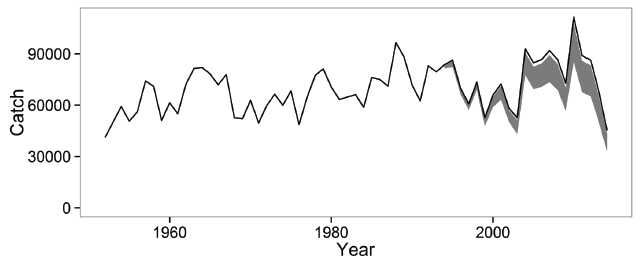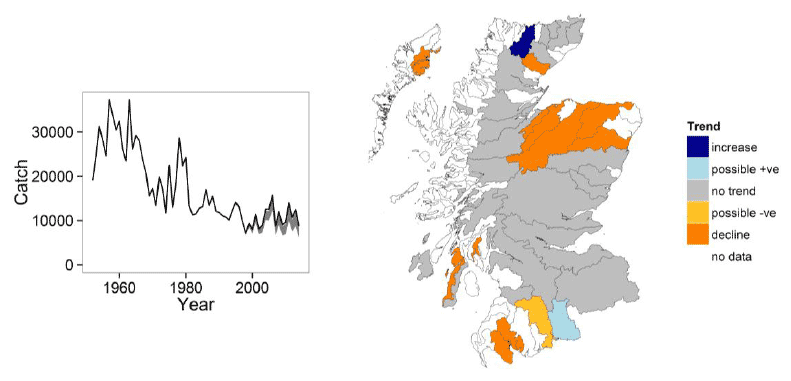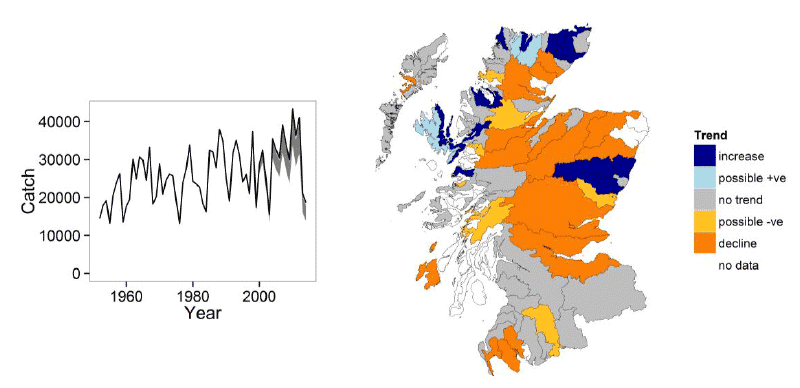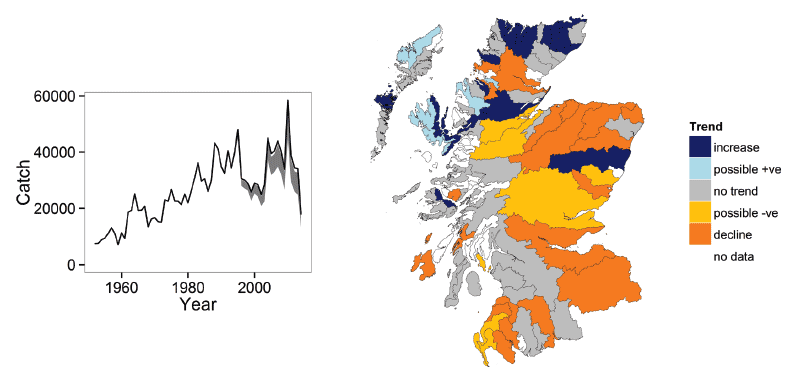Marine Scotland Science Report 01/15: Status of Scottish Salmon and Sea Trout Stocks 2014
Report assessing the status of Scottish salmon and sea trout stocks in 2014, based on the annual salmon and sea trout catch statistics.
Salmon
Rod Catches
Rod catches have traditionally been used to assess the status of salmon in Scotland. An underlying assumption of catch based assessments is that there has been no consistent change in the percentage of salmon captured by the fisheries (exploitation rate) over time or among rivers. Exploitation rate may be influenced by a number of factors including river flow, fishing effort and fishing efficiency. It is also clear that the practice of catch and release can inflate catch figures by allowing re-exploitation of individual fish. In this report we account for the effect of catch and release using the methods presented by Smith et al. (2014). This correction requires knowledge of exploitation rates and the mortality associated with catch and release. The release mortality was assumed to be 10% (Smith et al. 2014). There are limited data on exploitation rates of salmon in Scotland, although they are known to vary between seasons and locations. This report adjusts reported rod catches using a range of plausible exploitation rates ranging from 5% to 35% (data for UK summarised by Thorley et al. 2007).
The potential limitations of rod catch data should be considered when interpreting catch based assessments. However, rod catches are the most comprehensive indicator of stock status in terms of temporal and geographical coverage, and in many areas are the only information available.
Marine Scotland Science has developed a tool that allows a simple, straightforward analysis of rod catch to highlight situations where there has been evidence of recent changes in salmon catches at a specified level of statistical significance. The rod catch tool examines the past twenty years of salmon catch data aggregated into seasonal groupings and determines whether or not there is evidence of a change. The tool uses a simple rule based system - with an 11% chance of a trend being identified by chance. Conventionally, the tool was used to highlight areas where stocks may be in decline and thus where further investigation was considered prudent. However, it can also be used to identify those areas where reported catches may be increasing. Here we present information on recent temporal trends that can be either positive or negative.
Catch data were aggregated into 109 geographical districts, each corresponding to a single river catchment or to groups of neighbouring river catchments. Where possible, the rod catch tool was run using the last 20 years data (1995-2014) for the three seasonal stock components in each fishery district. District boundaries are shown in the accompanying figures. The rod catch tool was run using the catches corrected for minimum and maximum expected exploitation rates. Where the rod catch tool suggested an increase or a decline irrespective of the exploitation rate these trends are reported as an increase or decrease. Where the trend depends on the exploitation rate, the district is categorised as showing a possible increase/decrease.
Annual Rod and Line Catch (Scotland)
The total national reported catch (retained + released across all Scotland) of salmon by rod-and-line fisheries increased over the period 1952-2010. However since 2010 it has declined, with the uncorrected catch for 2014 being the second lowest on record (Figure 1). It is not clear at this stage whether this decline is part of a longer term trend or a short term fluctuation, as has been seen throughout the time series. While catch and release may have had a small effect on reported catch, it was not sufficient to change the overall trend. Catch and release may, however, have been sufficient to increase total catch in 2014 above the previous low seen in 1952, so 2014 may be a new all-time low.
Figure 1: Total number of salmon reported to have been caught by rod-and-line fisheries in Scotland 1952-2014. The line indicates the total reported catch (retained and released) and the shaded area the catch corrected for the effect of catch and release.

Although the trend in annual catches is influenced by a number of factors, to some extent it reflects changes in distant water and coastal net fisheries. Hence, the trend of salmon returning to fresh water does not directly reflect survival at sea, but instead a combination of natural and fisheries mortality.
Spatial and Temporal Variability in Rod and Line Catches
Spring
At the national scale, reported catches of spring salmon have declined over much of the time since records began in 1952. Catches have stabilised in the past two decades, albeit at a lower level. The overall trend is similar after accounting for the impact of catch and release (Figure 2). Examination of the last 20 years of catches at a district scale reveals a varied picture, although there appears to be a cluster of rivers centred about the Spey which exhibit significant declines. Of those 37 districts where there were sufficient data to enable application of the rod catch tool, there is no evidence of a trend in the majority (22) of districts, declines in 13 and increases in two.
Figure 2: Trends in the reported catches of salmon during spring months (left). The line indicates the total reported catch (retained and released) and the shaded area the catch corrected for the effect of catch and release. The map (right) illustrates the results of the rod catch tool for spring salmon by statistical district.

Summer
Figure 3: Trends in the reported catches of salmon during summer months (left). The line indicates the total reported catch (retained and released) and the shaded area the catch corrected for the effect of catch and release. The map (right) illustrates the results of the rod catch tool for summer salmon by statistical district.

Long term trends in the reported summer catches are more favourable than those for spring, with an increasing trend until 2012 followed by a decline (Figure 3). Although there was a marked decline in the past few years it is not possible to say if this is part of a longer term trend or a short term fluctuation. Consideration of the effects of catch and release reduce the estimated catch but do not alter the overall trend. The rod catch tool suggests evidence of recent increases in 17 districts with a further 36 showing no change and reductions in 23.
Autumn
In common with the overall reported catch, there was a strong positive trend in national autumn catches over much of the time series up until 2010 (Figure 4). There has since been a decline in catches that represents the largest downward trend in the time series. However, there was also substantial regional variation about this trend. Of the 82 districts examined, 20 were characterised by increases, in 35 there was no change and declines were evident in 27 districts.
Figure 4: Trends in the reported catches of salmon during autumn months (left). The line indicates the total reported catch (retained and released) and the shaded area the catch corrected for the effect of catch and release. The map (right) illustrates the results of the rod catch tool for autumn salmon by statistical district.

Counters
Counters can provide a valuable catch-independent indicator of salmon abundance, provided that they are subject to careful validation and quality control. Validation requires verification that apparent counts are genuinely fish and also that fish are not missed by the counter. Marine Scotland Science operates three counters across Scotland, two on the North Esk (Logie on the main-stem river and Westwater on a major tributary) and one, in collaboration with the Helmsdale District Salmon Fisheries Board, on the river Helmsdale. Careful validation and quality control have been undertaken only at the North Esk sites.
Contact
There is a problem
Thanks for your feedback